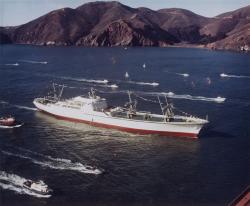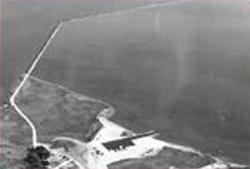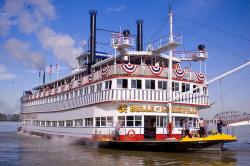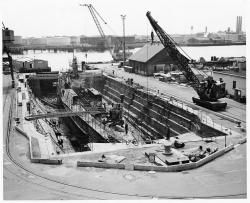The N.S. Savannah was the first nuclear-powered cargo-passenger ship, built by the New York Shipbuilding Corporation at Camden, New Jersey. The 74 maximum-power thermal megawatt pressurized-water reactor was supplied by the Babcock & Wilcox Company. Nearly 600 feet long with 22,000-tons displacement, the ship at top speed surged along at 24 knots, with more than 22,300 shaft horsepower to a single propeller. A joint venture by the U.S. Maritime Administration and the Atomic Energy Commission to the design of George G. Sharp Inc.
Water Transportation


Delaware 19709New CastleState: DECountry: USAWebsite: http://www.asce.org/Project/New-Castle-Ice-Harbor/Creator: Delafield, Richard
In 1794, the Delaware legislature authorized a lottery to fund the erection of ice piers in the harbor at New Castle. The ice harbor was designed to protect anchored ships from storms and ice. At the time, New Castle served as the principal winter port for ships from the Port of Philadelphia because ice on the Delaware River posed such a serious hazard to the wooden-hulled vessels. The harbor was the first of its type on the river and the last one to be maintained as the need for them declined. It served as a model for the other four harbors constructed in the area.

Minot's Ledge is a wave-swept rock formation in a rocky area of ocean about a mile off the Cohasset shore near Boston. Numerous serious shipwrecks prompted the government to erect a beacon there, and construction began in the summer of 1847.
The light, constructed on tall iron legs, was put into operation on January 1, 1850. Designers believed that the water would flow freely through the legs, leaving the lighthouse intact. But a terrible winter storm toppled it in 1851, killing the two assistant keepers.
While the Erie Canal has become well-known in the annals of American history, the Middlesex Canal, built two decades earlier and a model for canal engineers throughout young America, has only recently become recognized for its important achievements. Extending 27 miles northeast from Boston harbor to the Merrimack River near present-day Lowell, Masachusetts, the Middlesex Canal provided low-cost and efficient freight transport for almost five decades, helping to establish the canal in the U.S. as a viable means of economic development.


The oscillating steam engine, built by John Penn & Sons, is located aboard the famed paddle steamer Diesbar. Diesbar is the second oldest of a fleet of nine paddle steamers in Dresden. What makes the Diesbar unique is its coal fueled engine and single deck design. The John Penn and Sons engine that runs the steamer is the oldest operational marine steam engine in the world. It has been in operation for over 165 years.

The 50-mile Houston Ship Channel is a manmade port for ocean-going vessels, stretching from the Gulf of Mexico to Houston and Harris County, Texas.

AleNGothenburgState: Västra Götaland CountyCountry: SwedenWebsite: http://www.asce.org/Project/Gota-Canal/Creator: von Platen, Baltzer, Telford, Thomas
The Gota Canal is the biggest infrastructure project ever built in Sweden. The canal was dug by hand with shovels made of wood. It took over 22 years of 12-hour days - an estimated 12 million man-days of labor - to complete the project.




